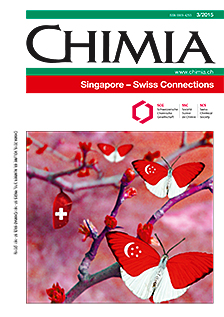Characterization of Lipid and Cell Membrane Organization by the Fluorescence Correlation Spectroscopy Diffusion Law
DOI:
https://doi.org/10.2533/chimia.2015.112Keywords:
Fluorescence correlation spectroscopy, Fcs diffusion law, Lipid raft model, Membrane dynamics, Membrane organization, Picket-fence modelAbstract
The plasma membrane organization of live cells defines a plethora of cellular processes important for cell functionality. Many membrane structures that define this organization exist at a spatial resolution below the optical diffraction limit and are highly dynamic. Therefore, a method with millisecond time resolution and nanometer spatial resolution is required for the investigation of plasma membrane organization. However, spatial and temporal resolutions of the currently available biophysical techniques are often mutually exclusive. In a novel realization, Lenne and coworkers developed a spot-variation modality of fluorescence correlation spectroscopy (FCS), also known as FCS diffusion law, to harvest nanoscopic information from microscopic measurements. The FCS diffusion law, so far, has been instrumental to decode the physico-chemical origin of membrane organization and its relationship with biological processes. Overall, the structural information of plasma membrane obtained by FCS diffusion law provides a better understanding of its coupling to the underlying cellular processes.Downloads
Published
2015-03-25
Issue
Section
Scientific Articles
License
Copyright (c) 2015 Swiss Chemical Society

This work is licensed under a Creative Commons Attribution-NonCommercial 4.0 International License.
How to Cite
[1]
X. W. Ng, N. Bag, T. Wohland, Chimia 2015, 69, 112, DOI: 10.2533/chimia.2015.112.







